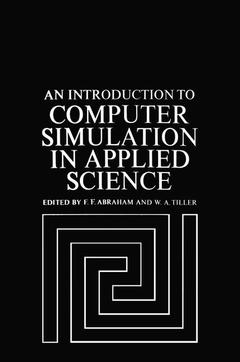Description
An Introduction to Computer Simulation in Applied Science, 1972
Coordinator: Abraham F.
Language: English
Subject for An Introduction to Computer Simulation in Applied Science:
Keywords
Publication date: 03-2012
220 p. · 15.2x22.9 cm · Paperback
220 p. · 15.2x22.9 cm · Paperback
Description
/li>Contents
/li>
This set of lectures is the outgrowth of a new course in the Department of Materials Science at Stanford University. It was taught collectively by the authors of the various sections and represents an attempt to increase the awareness of students in the materials area of computer simulation techniques and potentialities. The topics often ranged far afield from the materials area; however, the total package served the intended purpose of being an initiation into the world of computer simulation and, as such, made a useful first iteration to the intended purpose. The second iteration, which is in process, deals exclusively with the materials area. The course was designed to teach students a new way to wrestle with "systems" problems in the materials science work area that require the synthesis and interactions of several disciplines of knowledge. This course was a response to the realization that effective handling of real problems, which are essentially systems problems, is one of the most important at tributes of a graduate materials scientist. About a third of the course was devoted to the student's selected problem, in the materials area, which he simulated using the digital computer.
1. Rationale for Computer Simulation in Materials Science.- I. Introduction.- II. Patterns of Science.- III. The Student and His Research.- IV. Examples of Systems Events in the Crystallization Area.- A. An Overview of the Scientific Subroutines.- B. Technological Understanding of Ingot Defects.- C. Solute Distribution in Pulled Crystals.- 2. Lectures on Large-Scale Finite Difference Computation of Incompressible Fluid Flows.- I. The Differential Equations.- A. Introduction.- B. Numerical Solution of Laplace’s Equation.- C. The Inclusion of a Source Term and the Potential Solution.- D. The Time-Dependent Vorticity Field Due to Diffusion and Convection.- E. The Dynamic Equations and Scaling.- F. Suggested Reading.- II. Stability Analysis of the Difference Equations.- A. Introduction.- B. Stability Analysis of the Heat Conduction Equation.- C. Stability Analysis of Laplace’s Equation.- D. Stability Analysis of the Nonlinear Convection Equation.- E. Suggested Reading.- III. Applications of the Numerical Program for Incompressible Flow.- A. Introduction.- B. The Differential Equations of Fluid Flow.- C. The Difference Equations.- D. Karman Vortex Street Flows.- E. The Benard Problem.- F. References.- IV. Description of the Numerical Program for Incompressible Flow.- A. Discussion of the Block Diagram.- B. Discussion of the Program Listings.- C. Suggested Reading.- Appendix: Computer Listings of the Hydrodynamic Programs.- 3. Computer Simulation of Diffusion Problems Using the Continuous System Modeling Program Language.- I. Introduction.- II. System/360 Continuous System Modeling Program (S/360 CSMP).- A. Types of Statements.- B. Elements of a Statement.- C. Important Features of S/360 CSMP.- D. The S/360 CSMP Library of Functions.- E. The S/360 CSMP Library of Data and Control Statements.- F. Integration Methods.- G. The MACRO Function.- H. The Structure of the Model.- I. Advantages of S/360 CSMP.- J. Sample Problem.- III. Heat Transfer in an Insulated Bar.- A. Finite Differencing the Heat Equation.- B. Finite Difference Approach in the Modeling.- C. Fourier Solution.- D. The S/360-CSMP Solution.- IV. The Freezing of a Liquid.- A. Finite Differencing the Governing Equations.- B. The S/360-CSMP Solution.- 4. Computer Simulation of Vapor Deposition on Two-Dimensional Lattices.- I. Basic Concepts of Physical Processes.- A. Introduction.- B. The Honig Model.- C. The Simulated Processes.- D. The Rate Equations.- II. The Computer Simulation Model.- A. Boundary Conditions.- B. Evaporation, Migration, and Nearest Neighbor Effects.- C. Initial Conditions.- III. Random Numbers and Simulation Strategy.- A. Monte Carlo Methods.- B. Generation of Random Numbers.- C. Gaussian Distribution Generated by Random Numbers.- D. Use of Random Numbers to Select Dynamic Processes— Simulation Strategy.- IV. Real and Simulated Time.- V. The VDS Programs.- VI. The Computer Simulation Results.- References.- Appendix: Fortran Code.- 5. Introduction to Computational Theoretical Chemistry.- I. Basic Concepts of Computational Theoretical Chemistry.- II. The Nature of the Problem.- A. The Hydrogen Atom (Ground Electronic State).- B. The Helium Atom (Ground Electronic State).- III. Real Molecular Systems.- A. Introduction.- B. The Method of Hartree and Hartree-Fock.- C. Multicenter Integrals.- IV. The Calculation of Quantum-Mechanical Two-Electron Multi-center Integrals via Transformation Theory.- A. Introduction.- B. General Theory.- V. Computational Results.- References.- Appendix: Fortran Code.- 6. Numerical Simulation of Weather.- I. Physical Phenomena.- A .Introduction.- B. Magnitude and Range of the Problem.- C. Scaling Approximations.- D. Fundamental Conservation Equations.- II. Numerical Methods.- A. Physical Considerations.- B. Finite Difference Solutions and Nonlinear Instability.- C. Existing General Circulation Models.- D. Nonfinite Difference Methods in Numerical Weather Calculations.- III. Computer Requirements.- A. High-Speed Computer Characteristics.- B. Need for Supercomputers.- C. Estimates of Computer Requirements in Meteorological Calculations.- D. Programming Considerations.- E. Future Outlook.- References.
© 2024 LAVOISIER S.A.S.



